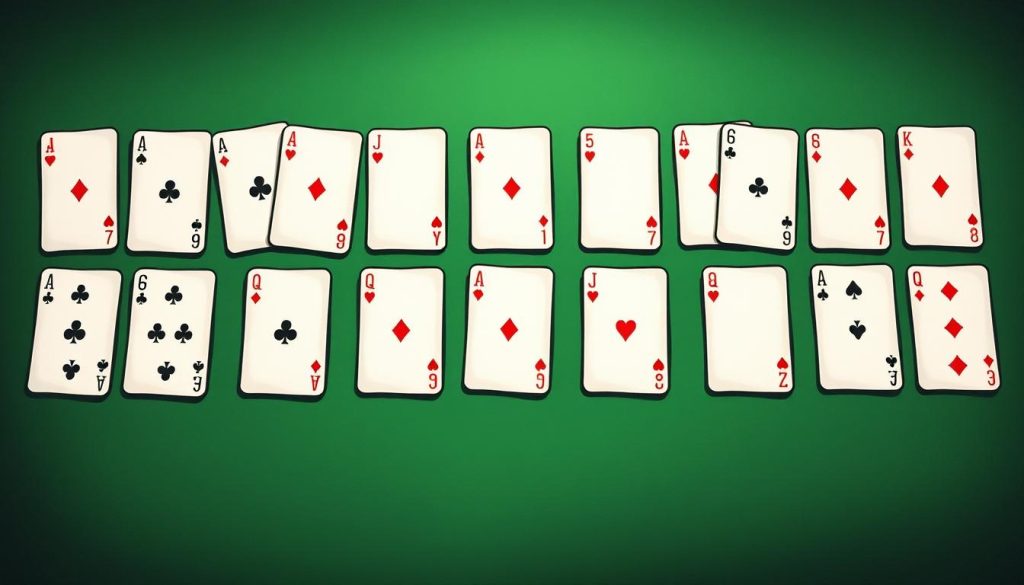Are you ready to deal yourself into the world of poker? Mastering the basics of Texas Hold’em is the first step towards becoming a skilled player. As a beginner, understanding the fundamentals is crucial to making informed decisions at the table.
So, how do you get started? With so many resources available, it can be overwhelming to know where to begin. The key is to start with the essentials: understanding hand rankings, learning basic strategies, and practicing regularly.
By focusing on these core elements, new players can build a solid foundation and improve their chances of success. Whether you’re playing with friends or joining online tournaments, having a grasp of the basics will help you navigate the game with confidence.
Key Takeaways
Table of Contents
- Understand hand rankings to make informed decisions
- Learn basic strategies to improve your gameplay
- Practice regularly to build your skills
- Focus on core elements to build a solid foundation
- Improve your chances of success with a strong understanding of the basics
Understanding the Basics of Texas Hold’em
To master Texas Hold’em, it’s crucial to start with a solid understanding of the game’s foundational elements. This includes knowing the game’s structure, the role of the dealer button, blinds, and the different stages of betting.
Game Structure and Objective
Texas Hold’em is typically played with 2-10 players. The objective is to win the pot by having the best hand or being the last player remaining in the hand. The game is divided into several rounds: pre-flop, flop, turn, and river.
The Dealer Button and Blinds
The dealer button rotates clockwise after each hand, indicating the dealer for that round. Blinds are forced bets that ensure there’s a pot to play for at the start of each hand. The two types of blinds are the small blind and the big blind.
Betting Rounds Explained
Betting rounds are crucial in Texas Hold’em. Here’s a breakdown:
Pre-Flop Action
Betting begins before the flop, with players acting based on their hole cards.
Flop, Turn, and River
The flop reveals three community cards, followed by the turn (fourth card), and the river (fifth card). Players bet after each of these rounds.
Showdown Process
If two or more players remain after the river, they enter a showdown, revealing their hands to determine the winner.
- Understanding these basics is key to improving your Texas Hold’em strategies.
- Mastering poker terminology and basic poker skills will enhance your gameplay.
Mastering Poker Hand Rankings and Terminology
To become proficient in Texas Hold’em, mastering poker hand rankings and key terminology is essential. Understanding the language of poker is crucial for making informed decisions at the table.
Essential Poker Terminology for Beginners
Familiarizing yourself with poker terminology helps you navigate the game more effectively. Here are some key terms grouped by category.
Table Position Terms
Understanding your position at the table is vital. Terms like “early position,” “middle position,” and “late position” refer to the order in which players act during each round.
Betting Action Terms
Knowing how to describe betting actions is crucial. Terms such as “check,” “bet,” “call,” “raise,” and “fold” are fundamental to communicating your actions.
Hand Description Terms
Describing your hand accurately is important. Terms like “pair,” “two pair,” “straight,” “flush,” and “full house” help you communicate your hand strength.
Hand Rankings from Strongest to Weakest
Understanding poker hand rankings is critical for evaluating your hand’s strength. Here is a breakdown from strongest to weakest.
Premium Hands: Royal Flush to Three of a Kind
The strongest hands in poker are: – Royal Flush: Ace, King, Queen, Jack, and 10, all of the same suit. – Straight Flush: Five cards in a row, all of the same suit. – Four of a Kind: Four cards of the same rank. – Full House: Three cards of one rank and two cards of another rank. – Flush: Five cards of the same suit. – Straight: Five cards in a row, but not all of the same suit. – Three of a Kind: Three cards of the same rank.
Common Hands: Two Pair to High Card
Other common hands include: – Two Pair: Two cards of one rank and two cards of another rank. – One Pair: Two cards of the same rank. – High Card: The highest card in your hand, used when you don’t have any of the above hands.
| Hand Ranking | Description | Example |
|---|---|---|
| Royal Flush | Ace, King, Queen, Jack, and 10, all of the same suit. | A♠, K♠, Q♠, J♠, 10♠ |
| Straight Flush | Five cards in a row, all of the same suit. | 9♥, 8♥, 7♥, 6♥, 5♥ |
| Four of a Kind | Four cards of the same rank. | A♦, A♥, A♣, A♠ |

By mastering poker hand rankings and terminology, you’ll be better equipped to make strategic decisions and improve your overall game.
Texas Hold’em Tips for Beginners: Starting Hand Selection
Mastering the art of starting hand selection is crucial for beginners looking to improve their Texas Hold’em game. The right starting hands can significantly increase a player’s chances of winning. In this section, we’ll explore the best beginner poker tips for selecting the right starting hands.
Premium Hands Worth Playing
As a beginner, it’s essential to know which hands are worth playing. Premium hands are those that have a high potential for winning. These include high pocket pairs and strong suited connectors.
Pocket Pairs
Pocket pairs are hands where both cards have the same rank, such as two 7s or two Kings. High pocket pairs like AA, KK, and QQ are particularly strong. Playing tight with these hands can be a good beginner Texas Hold’em strategy.
Strong Suited Connectors
Strong suited connectors are hands like 9-10 of the same suit or J-Q of the same suit. These hands have the potential to make strong straights and flushes, making them valuable in the right situations.
Position-Based Hand Selection
Position is a critical factor in Texas Hold’em. The position at the table can significantly influence which hands you should play. Understanding how to adjust your hand selection based on your position is a key starting hand selection strategy.
Early Position Strategy
In early positions, it’s best to play tight and stick to very strong hands. This means folding weaker hands and waiting for better opportunities.
Middle Position Strategy
In middle positions, you can slightly loosen your starting hand requirements. You can play a few more hands, but still be cautious.
Late Position Advantage
Being in a late position gives you a significant advantage. You can play more hands because you have more information about the actions of other players.
Hands to Fold Pre-Flop
Knowing which hands to fold pre-flop is just as important as knowing which to play. Weak hands like low unsuited connectors or very low pairs should typically be folded. A good rule of thumb is to fold hands that are unlikely to win or make a strong hand post-flop.
| Hand Type | Examples | Action |
|---|---|---|
| Pocket Pairs | AA, KK, QQ | Play |
| Strong Suited Connectors | J-Q suited, 10-J suited | Play |
| Weak Hands | 2-7 offsuit, 3-5 offsuit | Fold |
By mastering starting hand selection and understanding when to play or fold, beginners can significantly improve their Texas Hold’em game. Remember, the key to success lies in being selective and patient.
Essential Betting Strategies for New Players
Mastering betting strategies is crucial for new Texas Hold’em players to succeed. Betting is not just about placing chips in the pot; it’s a complex aspect of the game that involves strategy, psychology, and risk management.
Understanding Pot Odds and Expected Value
To bet effectively, new players must understand pot odds and expected value. Pot odds refer to the ratio of the current size of the pot to the cost of a contemplated call. Expected value, on the other hand, is a calculation that helps players determine whether a bet is likely to be profitable in the long run.
- Pot odds = Current pot size / Cost of call
- Expected value = (Probability of winning * Pot size) – (Probability of losing * Cost of call)
Understanding these concepts helps players make informed decisions at the table.
Bet Sizing Principles
Bet sizing is a critical aspect of betting strategy. It involves deciding how much to bet in a given situation. Effective bet sizing can help players maximize their winnings and minimize their losses.
Value Betting
Value betting involves betting when you have a strong hand, aiming to get value from your opponents. The goal is to bet enough to be called by weaker hands but not so much that opponents fold.
Continuation Betting
Continuation betting (CB) is a strategy where a player bets on the flop after raising pre-flop, regardless of whether they hit the flop or not. This can help build the pot with strong hands and bluff opponents off weaker hands.
Defensive Betting
Defensive betting is used to protect a hand from being outdrawn or to make it difficult for opponents to bluff. It’s about controlling the pot and managing risk.

Bluffing: When and How
Bluffing is an essential part of Texas Hold’em, but it should be used sparingly by new players. Bluffing involves betting or raising with a weak hand to deceive opponents into folding stronger hands. The key to successful bluffing is to understand your opponents’ tendencies and to bluff in situations where it’s likely to be effective.
- Choose the right opponents to bluff against.
- Consider the board texture and how it might affect your opponents’ perceptions.
- Don’t bluff too frequently, as this can make your betting patterns predictable.
By mastering these betting strategies, new players can improve their chances of success in Texas Hold’em.
Reading the Table and Avoiding Common Mistakes
One of the key skills for any Texas Hold’em player is the ability to read the table and adjust their strategy accordingly. As you gain experience, you’ll learn to observe your opponents’ actions, identify patterns, and make informed decisions to maximize your chances of winning.
Recognizing Betting Patterns
Recognizing betting patterns is crucial in Texas Hold’em. Players who bet aggressively may be trying to intimidate others, while those who bet conservatively might be hiding a strong hand. By paying attention to how your opponents bet, you can gain valuable insights into their strategy and make more informed decisions at the table.
Managing Your Bankroll
Effective bankroll management is essential for long-term success in Texas Hold’em. It’s recommended to allocate a specific amount for poker and stick to it. A general rule of thumb is to have at least 20-30 buy-ins for the stakes you’re playing. This helps you withstand variance and avoid going broke during downswings.
Emotional Control: Avoiding Tilt
Maintaining emotional control is vital in Texas Hold’em. Tilt refers to a state of emotional frustration that can lead to poor decision-making. To avoid tilt, take regular breaks, and don’t get too attached to your hand. Staying calm and composed, even during losing streaks, will help you make better decisions and improve your overall game.
By mastering these skills, you’ll be well on your way to becoming a proficient Texas Hold’em player. Remember, practice is key, so keep playing, learning, and adapting your strategy to become a formidable opponent at the table.
Conclusion
As a beginner, learning Texas Hold’em can seem daunting, but with the right strategies, you can improve your game and become a formidable player. By understanding the basics of Texas Hold’em, mastering poker hand rankings, and implementing effective betting strategies, you’ll be well on your way to success.
Remember, the key to improving your game is to practice consistently and stay focused. Apply the beginner poker tips outlined in this article, such as starting with premium hands, managing your bankroll, and avoiding common mistakes. As you gain more experience, you’ll develop your own style and become more confident at the table.
To take your game to the next level, continue to refine your skills by learning texas hold’em tips for beginners and staying up-to-date with the latest strategies. With persistence and dedication, you’ll be able to navigate complex game situations and make informed decisions that will help you win.
FAQ
What is the best way to start playing Texas Hold’em?
The best way to start playing Texas Hold’em is to understand the basics of the game, including the rules, hand rankings, and basic strategies. Start with low-stakes games or online platforms to practice without risking too much.
How do I choose the right starting hands in Texas Hold’em?
Choosing the right starting hands involves understanding the strength of your hand relative to your position at the table. Focus on playing premium hands like pocket pairs and strong suited connectors, and adjust your selection based on your position.
What is the importance of position in Texas Hold’em?
Position is crucial in Texas Hold’em as it determines the order in which you act during each betting round. Players who act later in the round have more information than players who act earlier, allowing for more informed decisions.
How do I manage my bankroll effectively in Texas Hold’em?
Effective bankroll management involves setting a budget for your poker activities and sticking to it. Allocate a specific amount for each session and avoid playing at stakes that are too high for your bankroll.
What are some common mistakes beginners make in Texas Hold’em?
Common mistakes include playing too many hands, failing to adjust to table dynamics, and not managing bankroll effectively. Beginners also often struggle with emotional control, leading to tilt and poor decision-making.
How can I improve my ability to read the table and opponents?
Improving your ability to read the table involves paying attention to betting patterns, body language, and other behavioral cues. Practice observing your opponents and adjusting your strategy accordingly.
What is bluffing, and how do I use it effectively?
Bluffing is the act of betting or raising with a weak hand to deceive opponents into folding. To bluff effectively, choose the right moments, such as when the board texture is favorable, and be mindful of your table image.
How do I understand pot odds and expected value in Texas Hold’em?
Understanding pot odds involves calculating the ratio of the current pot size to the cost of a contemplated call. Expected value is the average return on a particular action, considering all possible outcomes. Mastering these concepts helps in making informed betting decisions.
